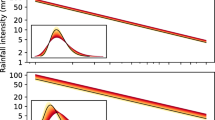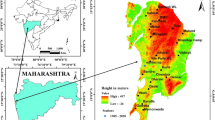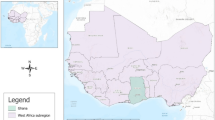Abstract
Daily rainfall records from seven stations in South Australia, with record lengths from 50 to 137 years and a common period of 36 years, are investigated for evidence of changes in the statistical distribution of annual total and annual average of monthly daily maxima. In addition, the monthly time series of monthly totals and monthly daily maxima are analysed for three stations for which records exceed 100 years. The monthly series show seasonality and provide evidence of a reduction in rainfall when the Southern Oscillation Index (SOI) is negative, which is modulated by the Pacific Decadal Oscillation (PDO). However, the monthly series do not provide any evidence of a consistent trend or of any changes in the seasonal pattern. Multivariate analyses, typically used in statistical quality control (SQC), are applied to time series of yearly totals and of averages of the 12 monthly daily maxima, during the common 36-year period. Although there are some outlying points in the charts, there is no evidence of any trend or step changes. However, some supplementary permutation tests do provide weak evidence of an increase of variability of rainfall measures. Furthermore, a factor analysis does provide some evidence of a change in the spatial structure of extremes. The variability of a factor which represents the difference between extremes in the Adelaide Hills and the plains increases in the second 18 years relative to the first 18 years. There is also some evidence that the mean of this factor has increased in absolute magnitude.













Similar content being viewed by others
References
Alexander LV, Arblaster JM (2009) Assessing trends in observed and modelled climate extremes over Australia in relation to future projections. Int J Climatol 29(3):417–435
Australian Bureau of Meteorology (BOM) (2011) Climate data online, available at: http://www.bom.gov.au/climate/data/index.shtml
Beecham S, Chowdhury R (2012) Effects of changing rainfall patterns on WSUD in Australia. J Water Manage 165(5):285–298
Chowdhury R, Beecham S (2013) Influence of SOI, DMI and Niño3.4 on South Australian rainfall. Stoch Environ Res Risk A Springer 27(8):1909–1920
CSIRO (2001) Climate projections for Australia, CSIRO Atmospheric Research: Melbourne, http://www.dar.csiro.au/publications/projections2001.pdf
Gallant AJE, Karoly DJ (2010) A combined climate extreme index for the Australian region. J Clim. doi:10.1175/2010JCL13791.1
Goul ABT, Gneneyougo Soro E, Kouassi W, Srohourou B (2012) Trends and abrupt changes in daily extreme rainfalls of Ivory Coast (West Africa). Hydrol Sci J 57(6):1067–1080
Harremoës P, Mikkelsen PS (1995) Properties of extreme point rainfall I: Results from a rain gauge system in Denmark. Atmos Res 37(4):277–286
Haylock M, Nicholls N (2000) Trends in extreme rainfall indices for an updated high quality data set for Australia 1910–1998. Int J Climatol 20:1533–1541
Kamruzzaman M, Beecham S, Metcalfe AV (2011) Non-stationarity in Rainfall and Temperature in the Murray Darling Basin, Journal of Hydrological Processes, Wiley 25(10):1659–1675
Kamruzzaman M, Beecham S, Metcalfe AV (2013) Climatic influences on rainfall and runoff variability in the southeast region of the Murray-Darling Basin. Int J Climatol Wiley 33(2):291–311
Kamruzzaman M, Beecham S, Metcalfe AV (2015) Estimation of trends in rainfall extremes with mixed effects models. J Atmos Res. doi:10.1016/j.atmosres. 2015.08.018
Kaufman YJ, Tanré D, Boucher O (2002) A satellite view of aerosols in the climate system. Nature 419:215–223
King A, Karoly D, Alexander L (2013) The blame for rain is mainly done in vain. http://theconversation.com/the-blame-for-rain-is-mainly-done-in-vain-17896 , access on 31st October 2013
Kuo YM, Chu H, Pan TY, Yu HL (2011) Investigating common trends of annual maximum rainfalls during heavy rainfall events in southern Taiwan. J Hydrol 409(3–4):749–758
Lucas JM, Saccucci MS (1990) Exponentially weighted moving average control schemes: properties and enhancements. Technometrics 32(1):1–12
Manly BFJ (2004) Multivariate statistical methods—a primer. Chapman and Hall, p208
Martín-Vide J, López-Bustins JA (2006) The western Mediterranean oscillation and rainfall in the Iberian Peninsula. Int J Climatol 26(11):1455–1475
Montgomery DC (2005) Introduction to statistical quality control, 5th edn. John Wiley and Sons, New York, p 256
Nowreen S, Murshed SB, Islam AS, Bhaskaran B, Hasan MA (2015) Changes of rainfall extremes around the Haor basin area of Bangladesh using multi-member ensemble RCM. Theor Appl Climatol 119(1–2):363–377
R Development Core Team (2011) A language and environment for statistical computing. R Foundation for Statistical Computing, Vienna, Austria, ISBN 3-900051-07-0
Robert SW (1959) Control chart tests based on geometric moving averages. Technometrics 1:239–250
Salinger MJ, Griffith GH (2001) Trends in New Zealand daily temperature and rainfall extremes. Int J Climatol 21:1437–1452
Shahid S (2011) Trends in extreme rainfall events of Bangladesh. Theor Appl Climatol 104:489–499
van den Besselaar EJM, Klein Tank AMG, Buishand TA (2013) Trends in European precipitation extremes over 1951–2010. Int J Climatol 33:2682–2689
Westra S, Sisson SA (2011) Detection of non-stationarity in precipitation extremes using a max-stable process model. J Hydrol 406(1–2):119–128
Willems P (2013) Multidecadal oscillatory behaviour of rainfall extremes in Europe. Climate Change 120:931–944
Willems P, Arnbjerg-Nielsen K, Olsson J, Nguyen VTV (2012) Climate change impact assessment on urban rainfall extremes and urban drainage: methods and shortcomings. Atmos Res 103:106–118
Acknowledgments
This study was funded by the Goyder Institute for Water Research under their Climate Change program. The researchers are grateful to the developers of the R project for software code and to the Australian Bureau of Meteorology for providing meteorological data.
Author information
Authors and Affiliations
Corresponding author
Appendices
Appendix 1
Appendix 2: Estimated coefficients of linear and quadratic terms t, SOI, PDO and their interaction effects on monthly daily maximum and monthly total rainfall using regression analysis
i Glen Osmond
Glen Osmond | ||||||||
|---|---|---|---|---|---|---|---|---|
Monthly daily maximum rainfall | Month total rainfall | |||||||
Estimate | Std. error | t value | P-value | Estimate | Std. error | t value | P-value | |
Average | 12.2400 | 1.228 | 9.967 | 0.000 | 24.2900 | 3.066 | 7.924 | 0.000 |
Linear t | 0.0028 | 0.003 | 0.931 | 0.352 | −0.0069 | 0.007 | −0.925 | 0.355 |
Quad. t | 0.0000 | 0.000 | 0.816 | 0.415 | 0.0000 | 0.000 | 1.682 | 0.093 |
Feb | −1.2900 | 1.652 | −0.780 | 0.435 | −3.7510 | 4.126 | −0.909 | 0.363 |
Mar | −0.2284 | 1.650 | −0.138 | 0.890 | 4.0720 | 4.120 | 0.988 | 0.323 |
Apr | 4.9260 | 1.652 | 2.982 | 0.003 | 25.7700 | 4.124 | 6.248 | 0.000 |
May | 8.5170 | 1.652 | 5.157 | 0.000 | 49.1600 | 4.124 | 11.919 | 0.000 |
June | 7.3240 | 1.650 | 4.437 | 0.000 | 56.1300 | 4.121 | 13.621 | 0.000 |
July | 5.5560 | 1.650 | 3.367 | 0.001 | 57.5900 | 4.120 | 13.978 | 0.000 |
Aug | 5.2430 | 1.652 | 3.174 | 0.002 | 50.9600 | 4.124 | 12.358 | 0.000 |
Sep | 3.7610 | 1.650 | 2.279 | 0.023 | 36.9800 | 4.121 | 8.975 | 0.000 |
Oct | 3.0330 | 1.651 | 1.837 | 0.066 | 26.6600 | 4.122 | 6.468 | 0.000 |
Nov | 2.3540 | 1.650 | 1.427 | 0.154 | 14.3300 | 4.119 | 3.479 | 0.001 |
Dec | 2.3160 | 1.650 | 1.404 | 0.161 | 7.8500 | 4.120 | 1.906 | 0.057 |
PDO | 0.3737 | 0.351 | 1.064 | 0.287 | 1.6830 | 0.877 | 1.920 | 0.055 |
SOI | 0.1162 | 0.034 | 3.390 | 0.001 | 0.4815 | 0.086 | 5.626 | 0.000 |
PDOxSOI | −0.0470 | 0.030 | −1.565 | 0.118 | −0.1434 | 0.075 | −1.912 | 0.056 |
ii Salisbury Bowling Club
Salisbury | ||||||||
|---|---|---|---|---|---|---|---|---|
Monthly daily maximum rainfall | Month total rainfall | |||||||
Estimate | Std. error | t value | P-value | Estimate | Std. error | t value | P-value | |
Average | 11.0000 | 1.117 | 9.848 | 0.000 | 18.8600 | 2.609 | 7.229 | 0.000 |
Linear t | 0.0001 | 0.003 | 0.026 | 0.979 | 0.0029 | 0.006 | 0.461 | 0.645 |
Quad. t | 0.0000 | 0.000 | 0.496 | 0.620 | 0.0000 | 0.000 | 0.305 | 0.761 |
Feb | 0.1940 | 1.503 | 0.129 | 0.897 | −0.0642 | 3.512 | −0.018 | 0.985 |
Mar | 1.1930 | 1.501 | 0.795 | 0.427 | 4.2700 | 3.507 | 1.218 | 0.224 |
Apr | 3.6490 | 1.502 | 2.429 | 0.015 | 18.5700 | 3.510 | 5.291 | 0.000 |
May | 5.8730 | 1.502 | 3.909 | 0.000 | 37.1100 | 3.510 | 10.573 | 0.000 |
June | 7.1290 | 1.501 | 4.749 | 0.000 | 44.6000 | 3.508 | 12.716 | 0.000 |
July | 2.6720 | 1.501 | 1.781 | 0.075 | 38.4100 | 3.507 | 10.952 | 0.000 |
Aug | 4.1140 | 1.502 | 2.738 | 0.006 | 39.2000 | 3.510 | 11.168 | 0.000 |
Sep | 3.7030 | 1.501 | 2.467 | 0.014 | 31.0800 | 3.507 | 8.861 | 0.000 |
Oct | 4.0470 | 1.502 | 2.695 | 0.007 | 21.9200 | 3.509 | 6.246 | 0.000 |
Nov | 2.2030 | 1.500 | 1.468 | 0.142 | 9.9220 | 3.506 | 2.830 | 0.005 |
Dec | 2.6210 | 1.501 | 1.747 | 0.081 | 7.0280 | 3.506 | 2.004 | 0.045 |
PDO | 0.6256 | 0.319 | 1.959 | 0.050 | 1.3750 | 0.746 | 1.842 | 0.066 |
SOI | 0.0989 | 0.031 | 3.172 | 0.002 | 0.4033 | 0.073 | 5.536 | 0.000 |
PDOxSOI | −0.0584 | 0.027 | −2.137 | 0.033 | −0.0943 | 0.064 | −1.478 | 0.140 |
Appendix 3
Rights and permissions
About this article
Cite this article
Kamruzzaman, M., Beecham, S. & Metcalfe, A.V. Changing patterns in rainfall extremes in South Australia. Theor Appl Climatol 127, 793–813 (2017). https://doi.org/10.1007/s00704-015-1667-8
Received:
Accepted:
Published:
Issue Date:
DOI: https://doi.org/10.1007/s00704-015-1667-8









